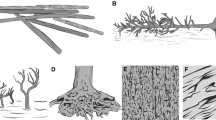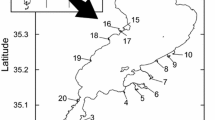Abstract
Lakeshore residential development (LRD) reduces coarse woody habitat (CWH) in lakes resulting in negative effects on fishes. We tested whether the addition of CWH could reverse those effects. We added CWH to Camp Lake, a lake with CWH abundances similar to developed lakes, following 2 years of study of the fish populations in the reference and treatment basins. Both basins were monitored for 4 years following the manipulation. Specifically, we tested for changes in the population dynamics (densities, size-structure, growth), diet, and behavior (habitat use) of bluegill (Lepomis macrochirus) and largemouth bass (Micropterus salmoides). CWH addition had no discernible effect on fish population dynamics. Diet and behavioral responses were more pronounced in the treatment basin. Prey diversity and availability increased. Piscivory increased, with decreased reliance upon terrestrial prey, for largemouth bass. Habitat use was positively correlated with CWH branching complexity and abundance. Our study suggests that negative effects observed in fish populations through CWH reductions cannot be reversed in the short-term by adding CWH. We recommend that regulations governing the LRD process be protective of CWH.






Similar content being viewed by others
References
Ahrenstorff TD, Sass GG, Helmus MR (2009) The influence of littoral zone coarse woody habitat on home range size, spatial distribution, and feeding ecology of largemouth bass (Micropterus salmoides). Hydrobiologia 623:223–233
Benke AC, Wallace JB (2003) Influence of wood on invertebrate communities in streams and rivers. In: Gregory S, Boyer K, Gurnell A (eds) The ecology and management of wood in world rivers. American Fisheries Society, Bethesda, pp 149–177
Carlander KD (1982) Standard intercepts for calculating lengths from scale measurements for some centrarchid and percid fishes. Trans Am Fish Soc 111:332–336
Carpenter SR (1998) The need for large-scale experiments to assess and predict the response of ecosystems to perturbation. In: Pace ML, Groffman PM (eds) Successes, limitations and frontiers in ecosystem science. Springer, New York, pp 287–312
Carpenter SR, Cunningham P, Gafny S, Munoz del Rio A, Nibbelink N, Olson M, Pellet T, Storlie C, Trebitz A (1995) Responses of bluegill to habitat manipulations: power to detect effects. N Am J Fish Manage 15:519–527
Christensen DL, Herwig BR, Schindler DE, Carpenter SR (1996) Impacts of lakeshore development on coarse woody debris in north temperate lakes. Ecol Appl 6:1143–1149
Eklov P (1997) Effects of habitat complexity and prey abundance on the spatial and temporal distributions of perch (Perca fluviatilis) and pike (Esox lucius). Can J Fish Aquat Sci 54:1520–1531
Everett RA, Ruiz GM (1993) Coarse woody debris as a refuge from predation in aquatic communities—an experimental test. Oecologia 93:475–486
Francis TB, Schindler DE (2006) Degradation of littoral habitats by residential development: woody debris in lakes of the Pacific Northwest and Midwest. United States Ambio 35:274–280
Francis TB, Schindler DE (2009) Shoreline urbanization reduces terrestrial insect subsidies to fishes in North American lakes. Oikos 118:1872–1882
Francis TB, Schindler DE, Fox JM, Seminet-Reneau E (2007) Effects of urbanization on the dynamics of organic sediments in temperate lakes. Ecosystems 10:1057–1068
Gabelhouse DW (1984) A length-categorization system to assess fish stocks. N Am J Fish Manage 4:273–285
Gaeta JW, Guarascio MJ, Sass GG, Carpenter SR (2011) Lakeshore residential development and growth of largemouth bass (Micropterus salmoides): a cross-lakes comparison. Ecol Freshwater Fish 20:92–101
George EL, Hadley WF (1979) Food and habitat partitioning between rock bass (Ambloplites rupestris) and smallmouth bass (Micropterus dolomieui) young of the year. Trans Am Fish Soc 108:253–261
Guy CS, Neumann RM, Willis DW, Anderson RO (2007) Proportional size distribution (PSD): a further refinement of population size structure index terminology. Fisheries 32:348
Helmus MR, Sass GG (2008) The rapid effects of a whole-lake reduction of coarse woody debris on fish and benthic macroinvertebrates. Freshwater Biol 53:1423–1433
Hillman WP (1982) Structure and dynamics of unique bluegill populations. M.Sc. Thesis, The University of Missouri, Columbia, Missouri, USA
Hodgson JR, Kitchell JF (1987) Opportunistic foraging by largemouth bass (Micropterus salmoides). Am Midl Nat 118:323–336
Hoff MH (1991) Effects of increased nesting cover on nesting and reproduction of smallmouth bass in northern Wisconsin. In: Jackson DC (ed) Proceedings of the first international smallmouth bass symposium. Mississippi Agricultural and Forestry Experiment Station, Mississippi State University, pp 39–43
Hunt J, Annett CA (2002) Effects of habitat manipulation on reproductive success of individual largemouth bass in an Ozark reservoir. N Am J Fish Manage 22:1201–1208
Hunt J, Bacheler N, Wilson D, Videan E, Annett CA (2002) Enhancing largemouth bass spawning: behavioral and habitat considerations. Am Fish Soc Symp 31:277–290
Jennings MJ, Emmons EE, Hatzenbeler GR, Edwards C, Bozek MA (2003) Is littoral habitat affected by residential development and land use in watersheds of Wisconsin lakes? Lake Reservoir Manage 19:272–279
Levins R (1968) Evolution in changing environments: some theoretical explorations. Princeton University Press, Princeton
Marburg AE, Turner MG, Kratz TK (2006) Natural and anthropogenic variation in coarse wood among and within lakes. J Ecol 94:558–568
Newbrey MG, Bozek MA, Jennings MJ, Cook JE (2005) Branching complexity and morphological characteristics of coarse woody structure as lacustrine fish habitat. Can J Fish Aquat Sci 62:2110–2123
Ricker WE (1975) Computation and interpretation of biological statistics of fish populations. Bulletian Fish Research, Board Can
Roth BM, Kaplan IC, Sass GG, Johnson PT, Marburg AE, Yannarell AC, Havlicek TD, Willis TV, Turner MG, Carpenter SR (2007) Linking terrestrial and aquatic ecosystems: the role of woody habitat in lake food webs. Ecol Model 203:439–452
Sass GG, Kitchell JF, Carpenter SR, Hrabik TR, Marburg AE, Turner MG (2006a) Fish community and food web responses to a whole-lake removal of coarse woody habitat. Fisheries 31:321–330
Sass GG, Gille CM, Hinke JT, Kitchell JF (2006b) Whole-lake influences of littoral structural complexity and prey body morphology on fish predator–prey interactions. Ecol Freshwater Fish 15:301–308
Savino JF, Stein RA (1989) Behavior of fish predators and their prey—habitat choice between open water and dense vegetation. Environ Biol Fish 24:287–293
Scheuerell MD, Schindler DE (2004) Changes in the spatial distribution of fishes in lakes along a residential development gradient. Ecosystems 7:98–106
Schindler DE, Hodgson JR, Kitchell JF (1997) Density-dependent changes in individual foraging specialization of largemouth bass. Oecologia 110:592–600
Schindler DE, Geib SI, Williams MR (2000) Patterns of fish growth along a residential development gradient in north temperate lakes. Ecosystems 3:229–237
Seaburg KG (1957) A stomach sampler for live fish. Progress Fish-Cult 19:137–139
Smokorowski KE, Pratt TC, Cole WG, McEachern LJ, Mallory EC (2006) Effects on periphyton and macroinvertebrates from removal of submerged wood in three Ontario lakes. Can J Fish Aquatic Sci 63:2038–2049
Spotte S (2007) Bluegills: biology and behavior. Am Fish Soc, Bethesda
Stewart-Oaten A, Murdoch WW, Parker KR (1986) Environmental impact assessment: Pseudoreplication in time? Ecology 67:929–940
Vogele CE, Rainwater WE (1975) Use of brush shelters as cover by spawning black basses (Micropterus) in Bull Shoals Reservoir. Trans Am Fish Soc 104:264–269
Warner RR, Chesson PL (1985) Coexistence mediated by recruitment fluctuations: a field guide to the storage effect. Am Nat 125:769–787
Wege GJ, Anderson RO (1978) Relative weight (Wr): a new index of condition for largemouth bass. In: Novinger GD, Dillard JG (eds) New approaches to the management of small impoundments. Am. Fish. Soc., North Central Division, Special Publication 5. Bethesda, Maryland, pp 79–91
Werner EE, Hall DJ, Laughlin DR, Wagner DJ, Wilsmann LA, Funk FC (1977) Habitat partitioning in a freshwater fish community. J Fish Res Board Can 34:360–370
Acknowledgments
We thank Jeff Bierman, Justin Fox, Matt Guarascio, Jon Hansen, James Jenders, Adam Kautza, Zach Lawson, Michelle Nault, Steve Reinhardt, Matt Rounds, and J.J. Weis for field assistance. We are particularly indebted to those that helped with the CWH addition; Darren Bade, Chad Harvey, Matt Helmus, Susan Knight, Tim Kratz, Norman Mercado-Silva, Brian Roth, Chris Solomon, Scott Van Egeren, and Michelle Woodford. Jeff Bode, Steve Gilbert, and Jayne Wade of the Wisconsin Department of Natural Resources were instrumental for acquiring the permitting to conduct this research on Camp Lake. This research was funded by a National Science Foundation Integrated Graduate Education and Research Traineeship (IGERT) awarded to G.G. Sass, the North Temperate Lakes LTER, a Graduate Engineering Research Scholars (GERS) Fellowship awarded to J.W. Gaeta, and an NSF biocomplexity grant (DEB-0083545) awarded to S.R. Carpenter. Equipment was provided by the Anna Grant Birge Memorial fund to G.G. Sass. The University of Wisconsin-Madison, Center for Limnology, Trout Lake Station provided housing and support for this project.
Author information
Authors and Affiliations
Corresponding author
Rights and permissions
About this article
Cite this article
Sass, G.G., Carpenter, S.R., Gaeta, J.W. et al. Whole-lake addition of coarse woody habitat: response of fish populations. Aquat Sci 74, 255–266 (2012). https://doi.org/10.1007/s00027-011-0219-2
Received:
Accepted:
Published:
Issue Date:
DOI: https://doi.org/10.1007/s00027-011-0219-2




